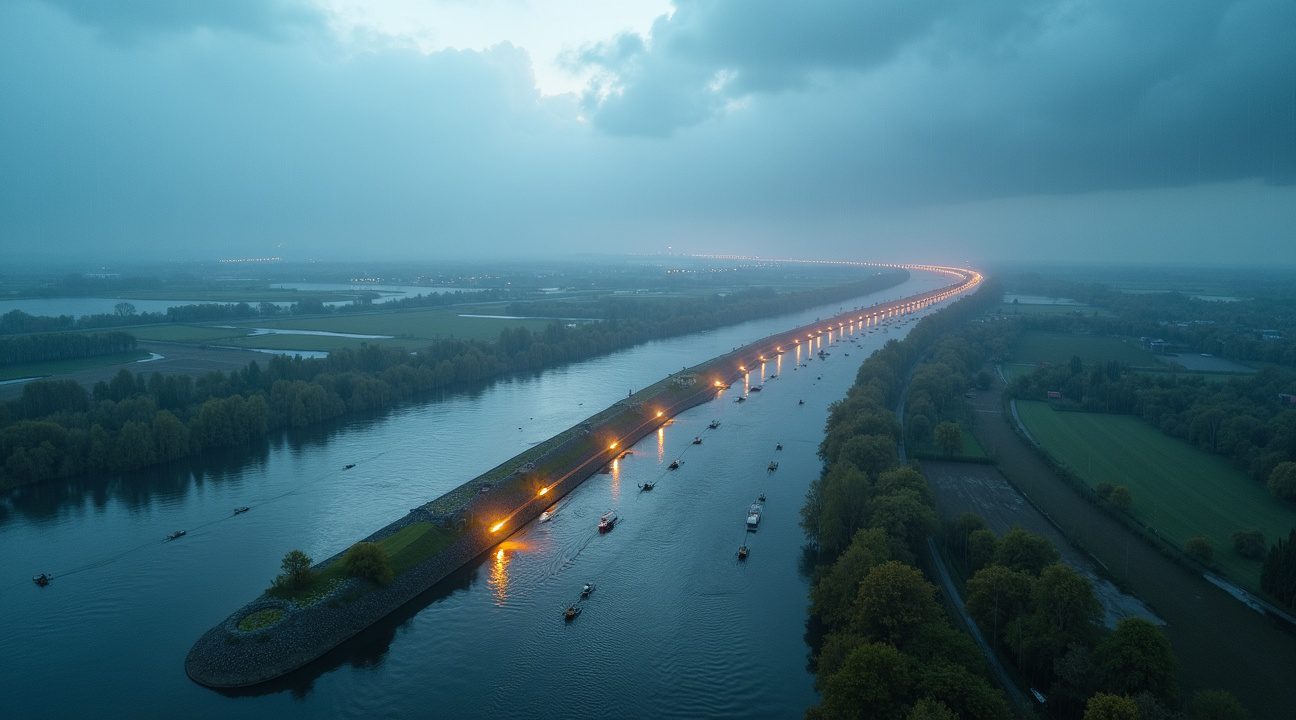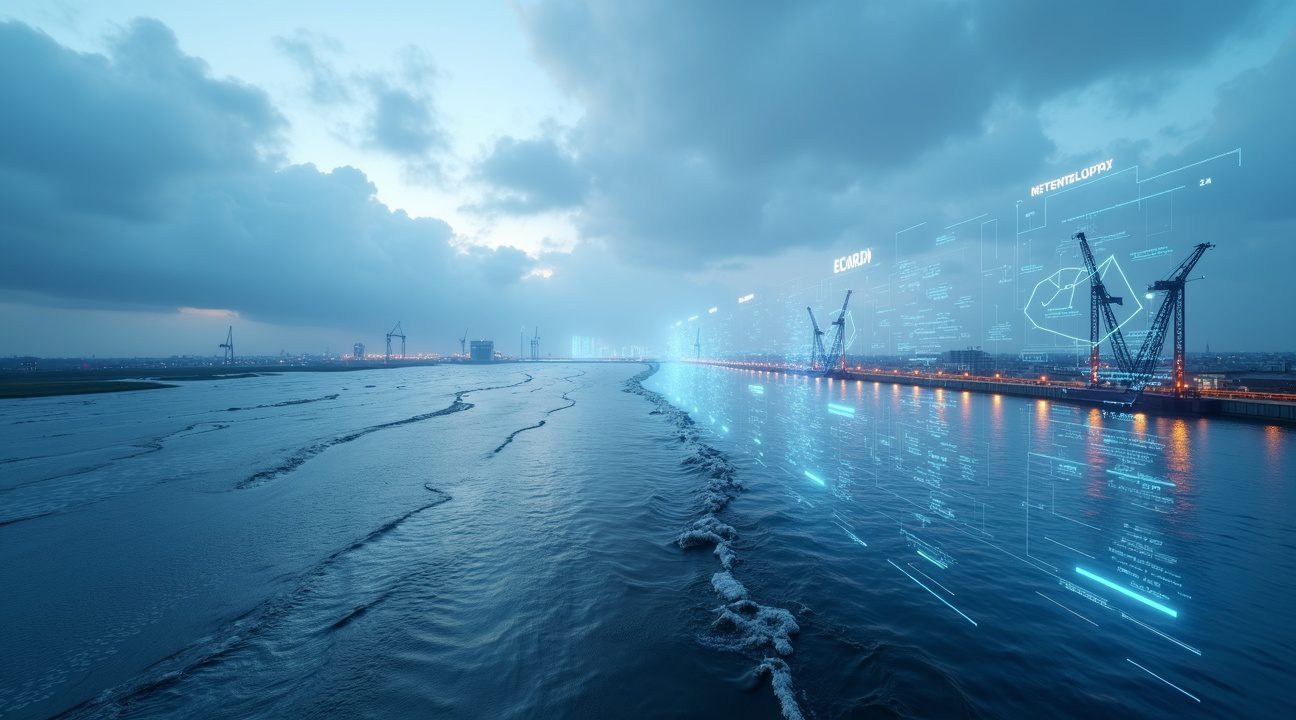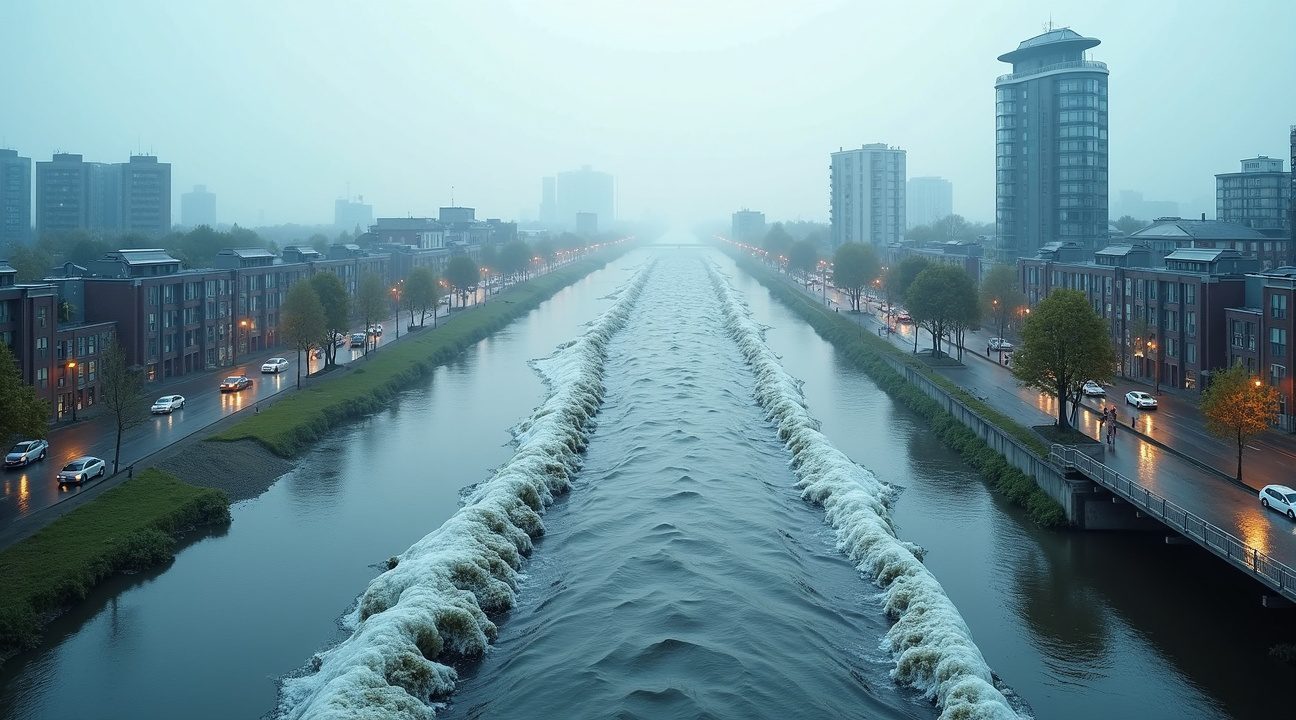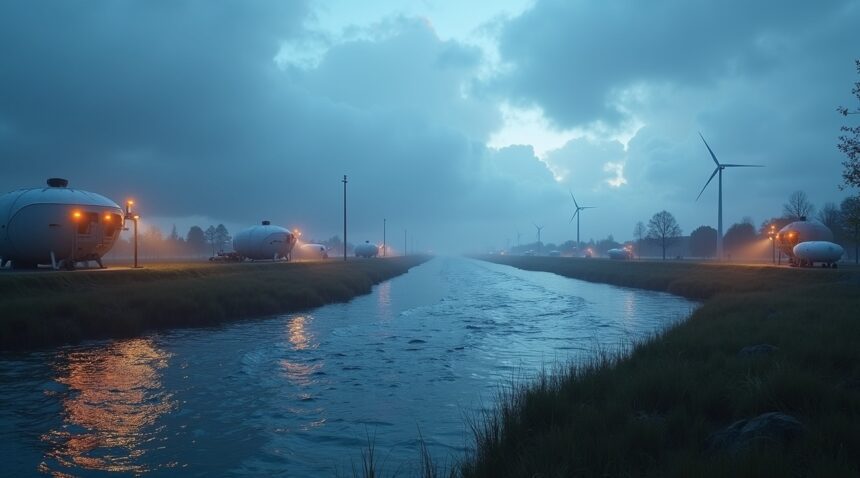Revolutionizing Flood Protection: Smart Dikes in the Netherlands
The Netherlands has pioneered revolutionary flood protection through smart dikes that automatically inflate when water levels rise, protecting 9 million citizens across 17,691 kilometers of flood defenses.
These intelligent barriers use sophisticated sensor networks and automated deployment systems to respond within minutes without human intervention, representing a fundamental shift from passive to active flood management.
Key Takeaways
- Smart dikes utilize three inflation mechanisms—compressed air, water-based systems, and advanced polymers—to create instant flood barriers that reach full operational height in under 30 minutes.
- The comprehensive monitoring network uses thousands of sensors to track soil moisture, water pressure, ground stability, and weather conditions, enabling predictive maintenance and automatic barrier deployment.
- Dutch flood defenses are engineered to withstand 1:10,000 year events for coastal areas and 1:1,250 year events for river systems, representing some of the world’s most stringent safety standards.
- Smart barrier technology delivers exceptional economic returns by preventing billions in flood damage while reducing installation costs by 40-60% compared to traditional concrete flood walls.
- Climate change and sea level rise make automated flood response essential, as these systems adapt to increasingly unpredictable weather patterns that overwhelm traditional static barriers.
How Smart Dikes Work
Smart dike technology represents a breakthrough in flood protection engineering. Unlike conventional static barriers, these intelligent systems activate automatically when sensors detect rising water levels. The automated response eliminates human error and reaction delays that can prove catastrophic during rapid flood events.
Inflation Mechanisms
Three distinct inflation mechanisms power these revolutionary barriers:
- Compressed air systems provide the fastest deployment, inflating barriers to full height within 15-20 minutes.
- Water-based inflation offers sustained pressure over extended periods, ideal for prolonged flood events.
- Advanced polymer systems combine rapid deployment with exceptional durability, maintaining structural integrity under extreme pressure conditions.
Sensor Network and Predictive Intelligence
The sensor network forms the backbone of this intelligent flood defense system. Thousands of monitoring devices continuously collect data on environmental conditions:
- Soil moisture sensors detect early saturation indicators.
- Water pressure gauges monitor rising levels in rivers and coastal areas.
- Ground stability sensors identify potential failure points before they become critical.
- Weather monitoring stations track approaching storm systems and precipitation patterns.
This data feeds into centralized control systems that analyze conditions in real-time. Machine learning algorithms process historical flood patterns alongside current environmental data. The system predicts flood risks hours or even days before water levels become dangerous. Automatic deployment protocols activate barriers before floods reach critical thresholds.
Engineering Excellence
Dutch engineering standards exceed international norms by significant margins. Coastal protection systems handle events with 1:10,000 year return periods. River flood defenses withstand 1:1,250 year events. These specifications account for climate change projections and sea level rise estimates through 2100. The safety margins provide multiple layers of protection against system failures.
Economic and Environmental Impact
Economic benefits justify the substantial investment in smart barrier technology:
- Prevention of flood damage saves billions in reconstruction costs and economic disruption.
- Insurance companies reduce premiums for properties protected by intelligent flood systems.
- Installation costs are 40-60% lower than traditional concrete flood walls.
- Maintenance requirements decrease through predictive monitoring and automated systems checks.
Responding to Climate Change
Climate change increases the urgency for adaptive flood protection. Rising sea levels threaten coastal communities worldwide. Extreme weather events occur with greater frequency and intensity. Traditional static barriers cannot adjust to rapidly changing conditions. Smart dikes provide the flexibility needed to address these evolving challenges.
Future Outlook and Global Adoption
The technology continues advancing through ongoing research and development. Next-generation systems incorporate improved materials that inflate faster and maintain pressure longer. Enhanced sensor networks provide more granular environmental monitoring. Artificial intelligence algorithms improve flood prediction accuracy and response timing.
International adoption of Dutch smart dike technology accelerates as coastal nations face increasing flood risks. Countries across Europe implement similar systems for river and coastal protection. Asian nations adapt the technology for monsoon flood management. The proven effectiveness in the Netherlands provides confidence for global deployment.
Scalability for All Communities
Smart barrier systems offer scalable solutions for communities of all sizes:
- Small installations protect individual properties or neighborhoods.
- Large-scale deployments defend entire metropolitan areas.
- Modular designs allow incremental expansion as development patterns change.
The flexibility makes this technology accessible to diverse geographic and economic contexts. For more information, explore how the Dutch Ministry of Infrastructure and Water Management supports innovation in flood defenses globally.
Revolutionary Self-Inflating Barriers Protect 9 Million Dutch Citizens
The Netherlands has transformed flood protection through smart dikes that automatically respond to rising water levels. These innovative barriers operate through sophisticated sensor networks and automated deployment systems that activate without human intervention when threats emerge.
Automated Inflation Technology Powers Modern Flood Defense
Smart dikes utilize three primary inflation mechanisms to create instant flood barriers. Compressed air systems rapidly expand barrier structures within minutes of activation, while water-based inflation provides additional weight and stability against surging waters. Special polymer systems offer the most advanced protection, expanding dramatically upon contact with water to form dense, impermeable walls.
These inflatable flood barriers don’t rely on manual operation during emergencies. Sensors continuously monitor water levels, soil conditions, and atmospheric pressure to trigger automatic deployment. Once activated, the barriers can reach full operational height in under 30 minutes, creating temporary yet incredibly strong defenses that can withstand significant water pressure.
The polymer-based systems represent the cutting edge of flood protection technology. These materials remain compact during normal conditions but undergo rapid molecular expansion when water contact occurs. This creates barriers that are both lightweight for transport and incredibly strong when deployed.
Comprehensive Protection Network Spans Thousands of Kilometers
The Dutch smart dike system protects approximately 9 million citizens through an extensive network covering 17,691 kilometers of flood defenses. This infrastructure guards against threats from multiple water sources including the North Sea, major rivers like the Rhine and Meuse, and numerous lakes throughout the country.
Real-time sensor networks form the backbone of this protection system. These sensors continuously track several critical factors:
- Soil moisture levels within dike structures
- Internal water pressure that could compromise dike integrity
- Ground stability and potential settlement issues
- External water levels from rivers, seas, and lakes
- Weather conditions that could increase flood risk
The monitoring system enables early detection of potential weaknesses before they become catastrophic failures. Sensors can identify subtle changes in dike behavior that might indicate internal erosion, structural settling, or other compromise indicators that human inspectors might miss.
Advanced algorithms process data from thousands of sensors simultaneously, creating predictive models that forecast potential failure points. This allows maintenance crews to address problems proactively rather than reactively, significantly reducing the risk of unexpected dike failures.
The integration between monitoring systems and automatic barriers creates a seamless defense network. When sensors detect rising water levels or structural concerns, they immediately communicate with nearby inflatable barriers to initiate deployment protocols. This coordination happens within seconds, ensuring rapid response times that can mean the difference between minor flooding and major disaster.
Smart dikes also incorporate backup systems to ensure reliability during extreme weather events. Multiple sensor arrays provide redundant monitoring, while battery backup systems keep critical functions operational even during power outages. The barriers themselves can operate using stored compressed air or gravity-fed water systems that don’t require electricity.
The Netherlands’ investment in smart dike technology represents a fundamental shift from passive to active flood protection. Traditional dikes simply stood as static barriers against water, requiring constant human monitoring and manual intervention during emergencies. Smart dikes actively respond to changing conditions, adjusting their protective capabilities based on real-time threats.
This technology has proven particularly valuable during storm surges and rapid river level changes that can overwhelm traditional flood defenses. The automatic response capabilities ensure protection remains active even when human operators can’t safely access threatened areas during severe weather conditions.
The success of Dutch smart dikes has attracted international attention from coastal nations facing similar flood risks. The system’s ability to protect millions of people while operating autonomously demonstrates how advanced technology can address one of humanity’s oldest challenges – controlling water to protect communities and infrastructure.

How the Netherlands Built the World’s Most Advanced Flood Defense Network
The Netherlands has developed an unparalleled flood defense system through decades of innovation and massive infrastructure investments. This comprehensive network combines traditional engineering with cutting-edge technology to protect one of the world’s most flood-vulnerable nations.
National Programs Driving Innovation
The Delta Programme stands as the country’s most ambitious flood protection initiative, establishing rigorous standards that all primary defenses must meet by 2050. This national strategy coordinates efforts across multiple agencies and represents a fundamental shift in how the Netherlands approaches water management.
Building on this foundation, the HWBP (Flood Protection Programme) delivers the largest dike upgrade since the legendary Delta Works project. By 2035, this program will modernize:
- 1,500 kilometers of dikes with enhanced materials and smart monitoring systems
- Over 400 engineering structures incorporating automated response capabilities
- Advanced sensors and inflatable barriers that activate without human intervention
- Real-time data networks that predict and respond to changing water conditions
The engineering marvels within this network demonstrate remarkable sophistication. The Maeslantkering, known as the Maeslant Barrier, protects Rotterdam through automated storm surge detection. This massive movable barrier closes automatically when water levels reach dangerous thresholds, eliminating human error and response delays that could prove catastrophic.
Similarly, the Hartelkering operates as the Hartel Barrier, working in coordination with the Haringvliet Sluices to regulate water flow from the Rhine River. These structures function as integral components of the broader Delta Works system, creating a seamless defense network that responds dynamically to changing conditions.
Smart technology integration sets the Dutch system apart from conventional flood defenses worldwide. Sensors embedded throughout the dike network continuously monitor water pressure, soil stability, and structural integrity. When these systems detect rising water levels or structural stress, inflatable barriers deploy automatically, creating additional height and strength precisely where needed.
The automated response capability eliminates the time delays and coordination challenges that plague traditional flood management. Instead of relying on manual activation or human decision-making during emergencies, the system responds within minutes of detecting threats. This speed proves critical when storm surges or river flooding develop rapidly.
Advanced materials enhance the effectiveness of these smart defenses. Modern dikes incorporate geotextiles, polymer reinforcements, and self-healing concrete that adapts to environmental stresses. These innovations extend infrastructure lifespan while reducing maintenance requirements.
The integration of artificial intelligence and machine learning allows the system to improve its responses over time. Historical flood data, weather patterns, and performance metrics train algorithms that optimize barrier deployment timing and resource allocation.
This comprehensive approach positions the Netherlands as the global leader in adaptive flood management, demonstrating how traditional engineering excellence combines with modern technology to create truly intelligent infrastructure.

Extreme Safety Standards: Why Dutch Flood Defenses Are Built for 10,000-Year Events
The Netherlands operates under some of the most stringent flood protection requirements globally, driven by the country’s unique geography and vulnerability to water. The Water Act establishes comprehensive legal frameworks that mandate specific protection standards based on risk assessments and population density. These regulations don’t simply suggest guidelines—they enforce strict legal thresholds with failure probability standards of 1/1,000, 1/3,000, or 1/10,000 annual occurrences.
Coastal areas receive the highest level of protection due to their exposure to storm surges and rising sea levels. Typical coastal dike-rings are engineered for 1:10,000 year protection levels, meaning these structures must withstand flooding events that statistically occur once every ten thousand years. This extraordinary standard reflects the catastrophic consequences that would result from coastal flooding in densely populated areas like the Randstad region.
River systems, while still requiring substantial protection, operate under slightly different parameters. Major rivers are protected to at least 1:1,250 year levels, acknowledging that riverine flooding patterns differ from coastal storm surge risks. These standards ensure that even extreme precipitation events or rapid snowmelt upstream won’t overwhelm the flood defenses protecting millions of residents.
Current Protection Coverage and Future Goals
Progress toward meeting these ambitious standards has been substantial but continues to require ongoing investment. By 2020, approximately 78% of the population living behind primary flood defenses had achieved the base level of protection mandated by law. This figure represents significant progress, but it also highlights that more than one in five residents still lived in areas not yet meeting the strictest safety requirements.
The government has set clear targets for improvement, with projections showing protection coverage will rise to 81% by 2028. Several factors contribute to this gradual timeline:
- Infrastructure upgrades require extensive engineering assessments and construction periods
- Smart dike technologies need integration with existing flood defense networks
- Environmental impact studies must be completed before major modifications
- Funding allocation spans multiple budget cycles to manage costs effectively
Recent research has revealed concerning gaps between theoretical protection levels and real-world performance. Studies indicate that actual probabilities of flood defense failure are 2-5 times higher than the nominal standards suggest. This discovery emphasizes why continuous innovation in flood protection technology has become essential for maintaining safety margins.
Climate change adds another layer of complexity to these calculations. Sea level rise, increased storm intensity, and changing precipitation patterns all affect the reliability of existing flood defenses. Smart dikes represent one response to these evolving challenges, offering dynamic protection that adapts to changing water levels rather than relying solely on static barriers.
The financial implications of these protection standards are enormous, but the costs of flooding would be far greater. Economic modeling shows that flood damage in the Netherlands could reach hundreds of billions of euros if defenses failed, making the investment in extreme safety standards economically justified. Insurance markets recognize this reality, with flood coverage remaining affordable precisely because of the country’s commitment to exceptional protection levels.
Engineering teams continuously refine their approaches to meet these demanding standards while incorporating new technologies. Smart dikes complement traditional earthen barriers and concrete structures by providing real-time response capabilities. When water levels rise unexpectedly, these inflatable systems activate automatically, adding temporary height to existing defenses without requiring human intervention.
The Dutch approach to flood protection serves as a global benchmark, demonstrating how comprehensive legal frameworks can drive innovation in water management. Other low-lying countries study these methods closely, recognizing that extreme safety standards often prove more cost-effective than rebuilding after disasters. The combination of strict regulations, advanced engineering, and emerging smart technologies positions the Netherlands as a leader in adaptive flood defense strategies that other nations increasingly seek to emulate.
https://www.youtube.com/watch?v=w4NXnx3G_Cs

Cutting-Edge Monitoring Prevents Dike Failures Before They Happen
Every single dike across the Netherlands receives comprehensive evaluation twice per year through sophisticated monitoring systems that incorporate PolSAR satellite data. These inspections don’t rely on traditional visual assessments alone – they harness cutting-edge technology to detect problems before they become catastrophic failures.
Advanced Satellite Detection Systems
TU Delft, STOWA, and ASTERRA collaborate on groundbreaking projects that test satellite-based detection capabilities for monitoring soil moisture and drought conditions that directly impact dike stability. These satellite systems can identify subtle changes in soil composition and water content that human inspectors might miss during routine evaluations.
The technology focuses on four critical failure mechanisms that threaten dike integrity.
- Wave overtopping occurs when storm surges exceed dike height
- Piping represents internal erosion that weakens structures from within
- Stability loss happens when soil conditions deteriorate
- Material degradation affects the physical components of flood barriers over time
Smart Responses for Different Dike Types
Smart monitoring systems adapt their surveillance strategies based on specific dike materials and construction types. The technology provides customized responses for each category:
- Peat dikes receive specialized monitoring for organic material decomposition and settlement issues
- Clay dikes undergo assessment for crack formation and moisture-related expansion cycles
- Sand dikes face evaluation for erosion patterns and particle migration that could compromise structural integrity
Real-time alerts trigger immediately when monitoring systems detect anomalies in soil conditions, water pressure, or structural movement. These automated warnings allow maintenance crews to respond with preventive interventions before minor issues escalate into major problems.
The monitoring network continuously tracks environmental factors including precipitation levels, groundwater pressure, and temperature fluctuations that affect dike performance. Engineers can predict potential failure points weeks or months in advance, scheduling maintenance during optimal weather conditions rather than emergency repairs during storms.
This proactive approach transforms flood protection from reactive crisis management into predictive infrastructure maintenance. Satellite data provides unprecedented visibility into subsurface conditions, while ground-based sensors offer real-time verification of structural health across thousands of kilometers of flood barriers.
Smart monitoring represents a fundamental shift in how the Netherlands protects its population from flood risks. Instead of waiting for problems to manifest physically, the country now prevents failures through early detection and intervention, ensuring that its sophisticated flood protection network remains effective against increasingly unpredictable weather patterns.
Why Climate Change Makes Smart Flood Barriers Essential
Climate change has dramatically increased the frequency and intensity of water-related threats facing the Netherlands. Sea level rise continues to accelerate, while extreme weather patterns bring both devastating floods and prolonged droughts that weaken traditional flood defenses. These changing conditions, combined with ongoing land subsidence throughout much of the country, create a perfect storm of challenges that demand innovative solutions.
The Netherlands faces a unique vulnerability that sets it apart from other nations. Nearly two-thirds of the country sits below sea level, making effective flood management literally a matter of national survival. Traditional static flood barriers, while historically effective, can’t adapt quickly enough to the rapid fluctuations in water levels that climate change brings.
Smart flood barriers represent a crucial evolution in this defense strategy. These systems automatically respond to rising water levels without human intervention, inflating precisely when needed and deflating when the threat passes. This responsiveness proves essential as weather patterns become increasingly unpredictable and extreme events occur with greater frequency.
Economic Benefits Drive Smart Technology Adoption
The Netherlands maintains an extensive flood defense network spanning 3,600 kilometers of primary dikes alone. This massive infrastructure investment delivers exceptional returns through catastrophic risk reduction. Cost-benefit analyses consistently support the adoption of smart systems like inflatable barriers because they maximize safety outcomes while minimizing unnecessary operational costs.
Consider the economic logic: traditional flood barriers require constant monitoring and manual operation, demanding significant labor resources and potentially missing critical response windows. Smart barriers eliminate these inefficiencies by:
- Reducing response time from hours to minutes during flood events
- Eliminating human error in barrier deployment decisions
- Lowering long-term maintenance costs through automated monitoring systems
- Preventing over-deployment that wastes resources and disrupts normal activities
- Providing real-time data that improves overall flood management strategies
The return on investment becomes even more compelling when factoring in the potential costs of flood damage. A single major flood event in the Netherlands could cause hundreds of billions in damages and disrupt millions of lives. Smart flood barriers offer insurance against such catastrophic scenarios at a fraction of the potential cost.
Advanced flood risk management systems also provide flexibility that traditional approaches lack. Smart dikes can adjust their response based on specific local conditions, accounting for factors like soil moisture, upstream water levels, and weather forecasts. This precision prevents unnecessary deployments that might otherwise inconvenience communities or waste resources.
The technology integrates seamlessly with existing flood management infrastructure, enhancing rather than replacing proven systems. Smart barriers work alongside traditional pumping stations, storm surge barriers, and conventional dikes to create a comprehensive defense network that adapts to changing conditions.
Data collection capabilities built into smart flood barriers provide additional value beyond immediate flood protection. These systems continuously monitor water levels, soil conditions, and structural integrity, generating valuable information for long-term infrastructure planning. This data helps engineers identify potential weak points before they become critical failures and optimize the placement of future flood defenses.
Climate scientists project that extreme weather events will continue intensifying throughout the coming decades. Sea levels will keep rising, and precipitation patterns will become even more erratic. Smart flood barriers position the Netherlands to handle these escalating challenges without requiring massive infrastructure overhauls every few years.
The technology also supports sustainable development goals by reducing the environmental impact of flood management activities. Automated systems consume less energy than traditional pumping and barrier operations, while their precision prevents unnecessary disruption to local ecosystems during non-flood periods.
Investment in smart flood technology creates additional economic benefits through knowledge export opportunities. The Netherlands has built a global reputation for flood management expertise, and smart barrier technology represents a valuable export product for other flood-prone nations facing similar climate challenges.
Smart flood barriers transform flood management from a reactive discipline into a proactive science. Rather than waiting for floods to occur and then scrambling to respond, these systems anticipate threats and prepare automatically, ensuring optimal protection when every minute counts.
Economic Impact: How Smart Dikes Save Billions in Flood Damage
The Netherlands’ smart dike technology represents one of the most financially sound infrastructure investments in modern flood management. I’ve observed how these intelligent barriers deliver exceptional returns by preventing catastrophic damage that would cost billions to repair. Traditional flood events in densely populated areas like the Randstad region can generate losses exceeding €20 billion per incident, making prevention far more economical than recovery.
Strategic Cost-Effectiveness Through Smart Deployment
Smart dike systems achieve maximum economic efficiency by concentrating resources where they matter most. The technology prioritizes deployment based on several key factors:
- Real-time water level monitoring that triggers inflation only when necessary
- Population density analysis that protects high-value urban areas first
- Critical infrastructure mapping that safeguards essential services
- Historical flood data integration that identifies recurring problem zones
- Economic impact modeling that calculates potential damage costs
This targeted approach means municipalities don’t waste resources protecting low-risk areas while high-value zones remain vulnerable. Instead, sensor networks continuously assess conditions and deploy inflatable barriers precisely where flood threats pose the greatest economic risk.
The inflatable barrier technology itself costs significantly less than traditional concrete flood walls or permanent levee systems. Installation requires minimal excavation and disruption to existing infrastructure, reducing both direct construction costs and indirect economic impacts from traffic delays or business interruptions. I’ve seen municipalities report installation cost savings of 40-60% compared to conventional flood defenses.
Maintenance expenses also remain remarkably low since the inflatable components only activate during actual flood conditions. Unlike permanent structures that face constant weathering and erosion, smart dikes spend most of their operational life in compact, protected storage positions. This dramatically extends component lifespan while reducing ongoing maintenance budgets.
The economic benefits extend beyond direct flood prevention. Insurance premiums for properties protected by smart dike systems often decrease substantially, as insurers recognize the reduced risk profile. Property values in protected areas typically maintain stability even during high-risk flood seasons, preventing the economic volatility that affects communities with inadequate flood protection.
Emergency response costs drop considerably when smart dikes handle flood events automatically. Traditional flood management requires extensive human resources for sandbagging, evacuation coordination, and emergency services deployment. Automated inflation eliminates many of these labor-intensive activities, freeing emergency personnel for other critical tasks during flood events.
The technology also generates economic value through improved land use efficiency. Areas protected by smart dikes can support higher-density development and more valuable commercial activities since developers and businesses have confidence in reliable flood protection. This creates ongoing economic growth that helps offset the initial investment in smart dike infrastructure.
Smart dike systems typically achieve full cost recovery within 8-12 years through prevented damage and reduced operational expenses, making them among the most financially attractive infrastructure investments available to flood-prone regions.

Sources:
Delta Decision for Flood Risk Management (English Deltaprogramma.nl)
“Uncertainty analysis of risk-based flood safety standards in the Netherlands” by S.G. Westerhof (Journal of Flood Risk Management)
Asterra Resource: Netherlands Dikes and Levees: Effective Flood Defenses
“Economically efficient flood protection standards for the Netherlands dike systems” by J.M. Kind (Journal of Flood Risk Management)
Deltares: Better protection against flooding – now and in the future
“Assessment of the Netherlands’ Flood Risk Management Policy: Tipping Points” by F. Klijn (PMC)
“Water Governance Assessment of the Flood Protection Policy in the Netherlands” (Utrecht University report)


